I actually thought I had a rather good idea when I wrote my last post. I really do need to get all my naked looms warped, especially the large one, I fear I haven’t actually put a warp on it since I started this blog, and that was almost a year ago. Shame on me…
Largely I need to dye more warps, I was so inspired with the last set of warps I dyed, and I spent the better part of 2007 weaving up the yardage from all the dyed warps. I spent the whole spring of this past year sewing garments from that yardage, and I’m completely out of all my handwoven yardage (except vintage scraps) and there are no more dyed warps just hanging around to inspire me.
I am probably sitting on 50-75 pounds of white yarn. All kinds of white yarn. I’d say the bulk is rayon, and there is of course a lot of cotton as well. I’ve only a couple of large cones of a loop mohair and some beautiful cashmere and something, again, all white. All of it needs dyeing. I also have a cabinet full of MX dyes from Pro-Chem. I’ve been talking about doing a week of dyeing, but that would mean a week with nothing on the calendar demanding my time, where I can turn my space into a dye studio, and work uninterrupted.
Now I actually have the time, all my calendar commitments are finished for the year, and the yardage deadline for HGA Convergence Exhibit is a mere two months away. I need to get cracking. I decided to take advantage of the fact that my son is into me for more than $200. and put him to work. Winding warps is basically mindless work, hard to mess up, and I’d be working right next to him making sure that there are no screw-ups. He worked very slowly and very carefully, and I was pretty proud of how he stuck with it.
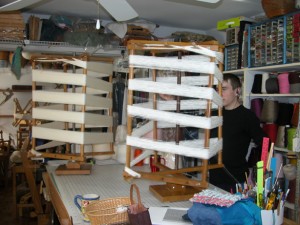
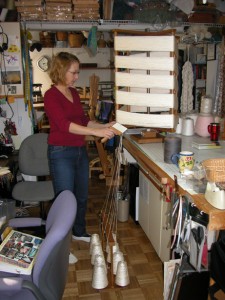
I pulled down all the white cones I thought I wanted to wind into 10 yard warps. I grouped cones together, If I had one gigantic cone, I gave it to my son, and he started to wind, single thread, listening to his tunes, and plodding along. I took advantage of cones where I had multiples of the same yarn, and used the paddle on another warping mill, and we both spent the weekend winding white warps.
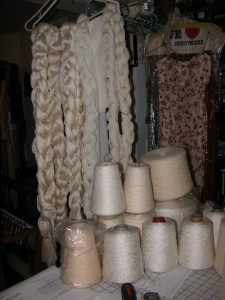
One of my readers, Diane, commented on the last post, asking why I didn’t use the AVL warping mill for this task. I thought about it, and decided that the standard warping mill was still the best, easiest to get a cross, and put a large amount of ends, I usually wind anywhere from 250-500 ends, depending on the size of the yarn and how much is on the cone. I’ll figure out later what I want to do with it. And I think it is easier to be able to tie everything off before chaining, when it is on a standard mill.
However, I did get to thinking about Diane’s
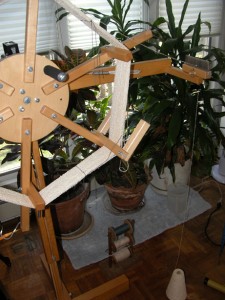
suggestion of using the AVL warping wheel and thought it was a pretty good idea for winding skeins for dyeing. I don’t think a three yard skein would fit on the umbrella swift for winding back into a ball once it is dyed, three yards being the outer perimeter of the AVL mill, but if I moved the brackets down the struts, I can get a two yard circumference, and that’s perfect for winding a skein. So I played around with the mill, I haven’t ever moved the brackets to the two yard set up, and I was surprised at how easy it was. I had a full skein on the wheel in no time, a lot faster than winding yarn for skeins around the standard mill. I just used the little reed to help guide the yarn into position on the wheel. Once the skein was wound, I just unbolted two of the brackets and popped them out and I could easily pull off the skein.
The yarn does me no good on the shelf, so I might as well just wind.
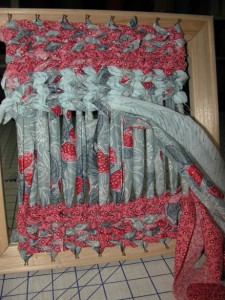
Meanwhile, I mentioned the Frances Irwin Handweavers meeting Monday the 9th, where member Jeri Shankler gave a lovely presentation on twining a mat. She made little frames for everyone, with nails across both ends, and we cut 2″ strips of quilt fabrics and warped with the fabric strips. Twining is actually a technique I use to use for texture when I did tapestry, so the concept came pretty quickly. She had an illustration and I can’t tell you how much fun I had just twining away with the fabric, chatting with the guild member next to me. I wanted to clear the project off my cutting table to make way for all the white yarn.
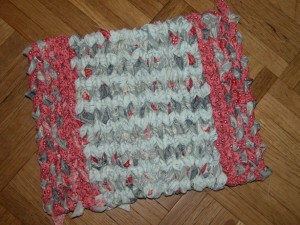
So I sat down the other night, and just finished it off. What a fun technique, so many techniques, so little time…
And last Sunday, in the middle of the guild show and sale, I went to Bergen County to the opening of the Focus on NJ exhibit at the Art Center of Northern NJ in New Milford. I enjoyed the exhibit, mostly painting and drawing, a few sculptures, but I got a shot of my two pieces hanging in the gallery space, happily living side by side with the other works.
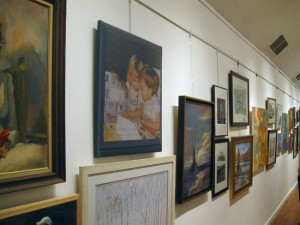
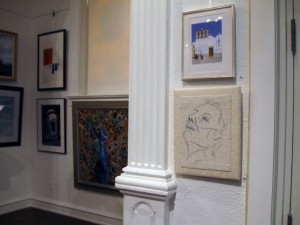
It is interesting to view my work in a two dimensional context, surrounded by more traditional fine art medium. I’m rather enjoying the exposure, and living in these two different worlds. In the handweaving community, the emphasis is on technique, how you did it, and the complexity of the structure, are really important. In the art community, how you did it is sort of a novelty, the tag only says, Mixed Media, but more importantly, it is about content and imagery. The piece is judged on the strength of the image. The technique is a distant second. And of course, the metaphor of weaving, constructing a life row by row, is so commonplace among the handweavers, we sort of take it for granted, and it isn’t important to the visual imagery of the piece, but in the art community, that metaphor of reconstruction becomes a critical part of the voice of the artwork.
Friday night, my husband and I took my daughter and a friend into NYC to see the off Broadway show, Avenue Q, for her birthday. My husband and I had seen the 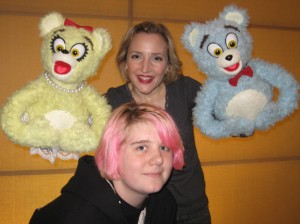 show many years ago, before it won the Tony Award, and now that it has moved off Broadway, into a smaller venue, we decided to take my daughter who has been dying to go every since she got hold of the score. To say this show is funny and biting would be a bit of an understatement. If you haven’t seen Avenue Q, it is an adult version of Sesame Street, with Henson puppets, and incredibly talented puppeteers, a biting satirical score, and some wonderful poking fun at some of the stupidity of the human race. My daughter didn’t stop laughing for the entire show. Her favorite characters were these two overly cute bears, that popped up at the most unfortunate times, called the “Bad Idea Bears”. They acted like the conscience of my 19 year old son and his friends, why buy a 6-pack when a case is more economical? And of course all of their bad ideas had some wickedly bad consequences.
show many years ago, before it won the Tony Award, and now that it has moved off Broadway, into a smaller venue, we decided to take my daughter who has been dying to go every since she got hold of the score. To say this show is funny and biting would be a bit of an understatement. If you haven’t seen Avenue Q, it is an adult version of Sesame Street, with Henson puppets, and incredibly talented puppeteers, a biting satirical score, and some wonderful poking fun at some of the stupidity of the human race. My daughter didn’t stop laughing for the entire show. Her favorite characters were these two overly cute bears, that popped up at the most unfortunate times, called the “Bad Idea Bears”. They acted like the conscience of my 19 year old son and his friends, why buy a 6-pack when a case is more economical? And of course all of their bad ideas had some wickedly bad consequences.
Anyway, after the show, the cast sold merchandise and a photo-op with the Bad Idea Bears and actress/puppeteer Maggie Lakis, as a fund raiser for Broadway Cares: Equity Fights Aids. I think Brianna felt this was the best birthday present ever.
Tomorrow: More warp winding…